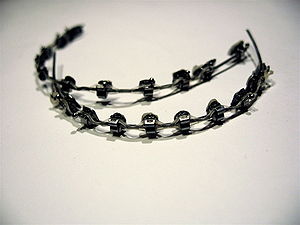
Orthodontic Braces
Orthodontic braces has been around for more than 50 years and even till now, it remain as the most popular choice in straightening crooked teeth by dental professionals. It is the safest method available and produces ‘true’ tooth straightening unlike teeth crowns or teeth veneers which simply masks the problem.
Am I too old for orthodontic braces?
There is no such thing as being too old for orthodontic braces, rather the question being, whether you actually need them or not. In the past orthodontic braces are used to straighten teeth mostly in children, but that is no longer the case as the continuously evolving orthodontics allow the possibility of adult teeth straightening with conventional orthodontic braces. More adults had sought orthodontic tooth straightening treatment to fix their crooked teeth and has achieved great results.
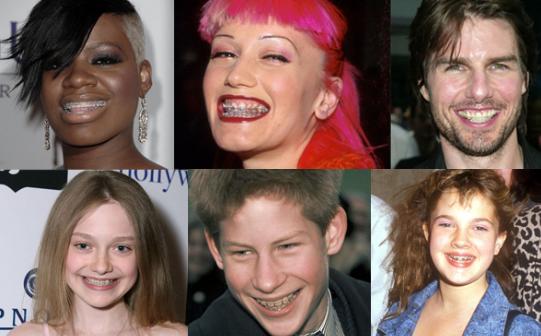
Celebrity with orthodontic braces
How do I know if I need orthodontic braces?
Orthodontic braces has many applications, the main being to straigthen crooked teeth. It can also be used to close unsightly gaps between teeth and correct overbites, overjets, open bites and cross bites or more commonly known as scissors bite. You or your child will most probably benefit from orthodontic braces if any of and not limited to the following problems are present:
- Poor aesthetics due to tooth position (crooked teeth, spaces between teeth or front teeth sticking out, teeth not biting together properly)
- Front teeth being prone to chipping
- Difficulty chewing or incising certain food, especially with front teeth (lettuce etc)
- Difficulty with speech (lisping, difficulty pronouncing certain sounds)
How orthodontic braces work?
Orthodontic braces are fitted by or under the supervision of an orthodontist, who has special training in the area of tooth straightening and repositioning of teeth. Conventional orthodontic braces involve the placement of a small bracket on each tooth which are then linked or tied together with a wire. This exerts an appropriate amount of force on the teeth in correct directions, moving the teeth in the process to realign them.
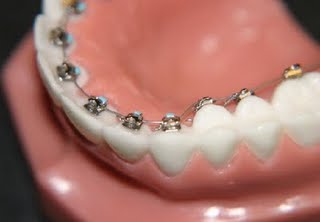
Lingual Braces
Orthodontic brackets are usually placed on the front surface of teeth. There are times when the brackets are placed on the inside surfaces of teeth, commonly referred to as lingual braces. Although this hides the orthodontic braces from view, it is an extremely uncomfortable option as the tongue is extremely sensitive and is in constant contact with the brackets and wire, making it prone to trauma.
Types of Braces
There are various types of braces, ranging from conventional metal braces to clear braces and more recently, invisible braces system known as Invisalign.
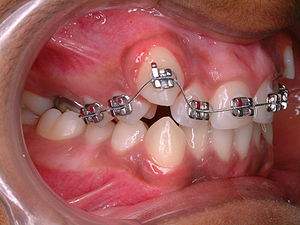
Metal braces in place to pull canine down into position
Conventional metal braces consist of metal brackets and wires that are mainly made from stainless steel, with some containing nickel titanium. Metal braces is the least aesthetic of all, but is gentle on our teeth as it does not tend to grind away edges of tooth upon contact.
Clear braces on the other hand has brackets which are made from ceramic or other plastic tooth coloured material, allowing them to be less visible to others. Metal wire are generally used though white wires and orthodontic rubber bands can be used to provide further cosmetic masking. Ceramic brackets although very aesthetically pleasing, are quite abrasive in nature, which can be a concern if the edges of teeth are in contact with the brackets.
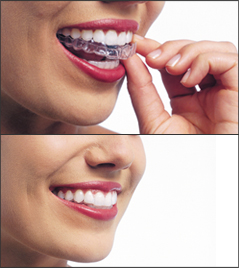
Invisible braces, Invisalign
Invisible braces are the most recent addition to the orthodontic braces family. But they are not really braces per se, as this tooth straightening method utilises a series of removable clear plastic aligners to move crooked teeth.This is the most aesthetic option but case selection is very important as it generally only works in mildly crowded teeth.
Although all types of braces straightens teeth, they can differ significantly in terms of application, making one option more suitable in some patients over others.
Cost of Braces
Depending on the country and state you are living in and whether or not you possess dental cover, orthodontic braces can be a costly treatment. The average price of braces in most countries such as US, Australia and Canada lies around 3500 to 5000 dollars. In Australia, children up to the aged of 18 are able to get orthodontic braces via public dental services for as low as AUD500. In the private system, metal braces generally cost around 3500 dollars, while clear braces can cost up to 5000 dollars. Invisible braces, such as the popular Invisalign system is the most costly, coming at a price tag of approximately 5000 to 7000 dollars.
How long does treatment takes?
Generally, orthodontic braces are worn for 18-24 months, depending on the type of braces used and mostly patient factors such as severity of crooked teeth, compliance and age.
Pros of orthodontic braces
- Most conservative method
- Does not damage tooth structure of existing teeth
- Results are often very good and long lasting if patient is compliant
Cons of orthodontic braces
- May require extraction of some teeth to make space
- Can be painful for the first week of insertion, and after tightening appointments
- Treatment takes 18 to 24 months to complete
- Braces inflicted injuries common with trauma to mouth region (fall over, slap in cheek/lips area)
- Tooth decay especially around bracket area common if oral hygiene is poor. It is important to look after your braces and use appropriate toothbrush.
Risks or dangers of orthodontic braces
- Tooth may lose vitality (pulp dies) especially if associated with trauma. This can become a problem especially when they are discoloured
- Teeth can be resorped, either at coronal (very rare) or root portion
Pingback: All You Need To Know About Tooth Straightening | Intelligent Dental
Pingback: More dental related stuff « s0hp0h (。◕‿◕。)
Pingback: Top tips to care for adult orthodontic braces | Intelligent Dental
Pingback: Tooth straightening with invisible braces | Intelligent Dental
Pingback: Revival entry, hopefully « s0hp0h (。◕‿◕。)
Pingback: Toothbrushes for Braces and Orthodontics | Intelligent Dental
Pingback: What Dental Corrective Surgery Could Do For You Part 1 | Intelligent Dental
Pingback: After orthodontic braces treatment: not the end | Intelligent Dental
my dentist installed a veneer on my front tooth and it looks better than ever*,*